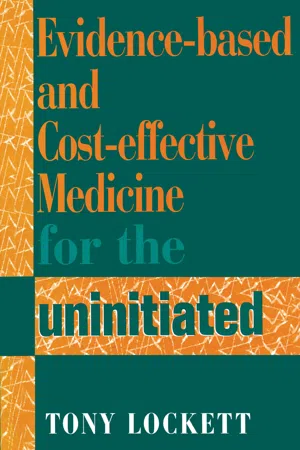
- 93 pages
- English
- ePUB (mobile friendly)
- Available on iOS & Android
Evidence-Based and Cost-Effective Medicine for the Uninitiated
About This Book
The use of home detoxification enables health care workers to avoid episodes of in-patient care, with its inherent high costs and secondary problems of label attachment and possible stigmatization. Patients, their carers (professional, voluntary and domestic), families and friends all involved in this 'at-home' process, thereby leading to empowerment and increased compliance. This book provides practical advice and guidance. If all the procedures here are followed, the care worker of whatever discipline is unlikely to encounter major difficulties. "Alcohol Home Detoxification and Assessment" provides the kind of model increasingly required for the move towards community care of people with a whole range of conditions, and will enable professionals to organize the process with confidence.
Frequently asked questions
Information
Part I Introduction
1 The levers of decision-making in medical practice
Why does health care exist?
Treatment | A | B |
Success : treated ratio | 1 : 6 | 1 : 4 |
Cost per treatment | £600 | £1500 |
Number treated | 38 | 12 |
Babies | 5 | 3 |
Information and levers for change
- Professional change. This includes evidence for the effectiveness of procedures, the effects of guidelines and the integrity of professional values. The application of professional levers also includes the use of audit and other performance measures based on process and outcome. These levers are the aim of evidence-based medicine and, to an extent, cost-benefit associated medicine. They are difficult to apply correctly, as we will see, but are a major focus.
- Customer change. This includes the satisfaction of patients, the understanding of patients about treatments, and the acceptability of treatment to patients. This is a difficult set of levers for change to apply. It is difficult, first, to define who the customers are, and second, to define who takes responsibility. This aspect is covered in greater detail in Part IV.
- Economic levers. These include the use of financial information to shift ideas and purchasing, and the use of contracting mechanisms. In the past the strength of financial levers has been over-emphasized. The strength of financial leverage depends on the amount of free, and freeable, funding available. However, studies have shown that the amount of uncommitted moneys may be small. In this circumstance the emphasis shifts to efficiency and demand management, both of which have a heavy professional input.
The nature of the levers and the process of rationing
- technocratic – where the professionals’ values and beliefs decide who benefits from he...
Table of contents
- Cover
- Title Page
- Copyright Page
- Contents
- Preface
- Part I Introduction
- Part II Evidence-Based Medicine
- Part III Cost-Effectiveness in Medicine
- Part IV Conclusion
- Index